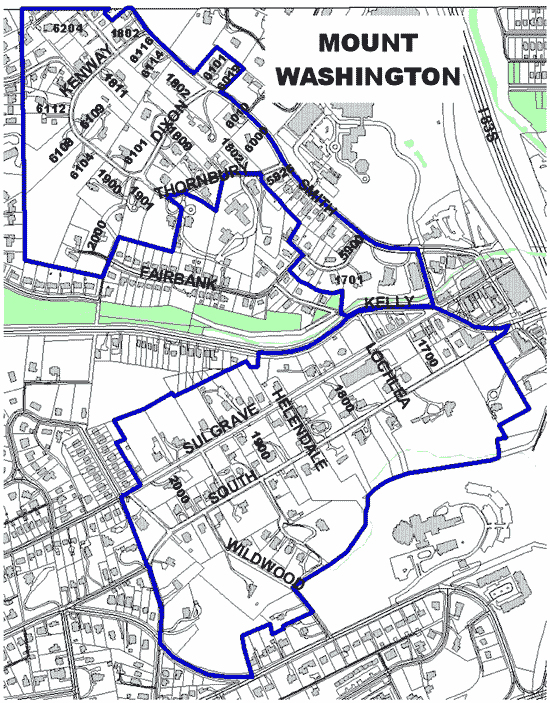Mount Washington
Description
 Mt. Washington is located in northwest Baltimore adjacent to Baltimore County. This Baltimore City Historic District is divided into two sections: to the southeast, South Road/Sulgrave, the first of the areas in which houses were built, and Dixon's Hill, to the north, which was an entrepreneurial project of the well known Baltimore architect Thomas Dixon. The two areas are separated from each other by Kelly Avenue. The district is characterized by frame houses, built individually or in small groups, on large irregularly shaped lots resulting in large expansions of historic open space.
Mt. Washington is located in northwest Baltimore adjacent to Baltimore County. This Baltimore City Historic District is divided into two sections: to the southeast, South Road/Sulgrave, the first of the areas in which houses were built, and Dixon's Hill, to the north, which was an entrepreneurial project of the well known Baltimore architect Thomas Dixon. The two areas are separated from each other by Kelly Avenue. The district is characterized by frame houses, built individually or in small groups, on large irregularly shaped lots resulting in large expansions of historic open space.
Examples of most of the major late 19th and early 20th century building styles used in domestic architecture are present in Mt. Washington. This includes Gothic Revival, Colonial Revival, Italianate, Octagon, etc. Although modern houses have been introduced into Mt. Washington they follow the earlier settlement patterns on large lots. The neighborhood still has a high degree of integrity, its landscape has changed little over time and the curving streets have not been severely altered.
Significance
Mt. Washington is considered by some sources to be Baltimore's first suburb. The area's progression from a summer retreat to an active Baltimore suburb contributes to an understanding of the development of Baltimore, the spread of the city's population in to the county due to improved transportation systems, and the movement of the white middle class away from downtown. Until the annexation of 1914 Mt. Washington was located in Baltimore County. Mt. Washington traces its origins to 1854 when two men, George Gelbach and Elias Heiner, purchased 314 acres of land near the mill village of Washingtonville. It was Gelbach's intention to establish a rural suburban retreat for Baltimore middle class professionals. Mt. Washington was only 15 minutes from downtown by train. The residents of this suburb could have both the conveniences of the city and the health and moral advantages of the country.
During its early years, the 1850s and into the 1860s, Mt. Washington consisted mostly of summer homes. It served as a retreat for Baltimoreans trying to escape the heat and humidity of the City. It was the intention, however, from the beginning for it to become a full-time suburb. Mt. Washington's growth slowed during the 1860s due to the Civil War and an economic recession. In the latter half of the 1860s building began again in earnest. It continued in the 1870s, often the product of developers who built small groups of houses. John Graham, a resident of Mt. Washington, is an example of such an entrepreneur. He was responsible for a great portion of what is now the South Road section of the district.
The northern section of the proposed Mt. Washington Historic District, Dixon's Hill, has its roots in 1855 when Thomas Dixon purchased 20 acres of land from Gelbach in order to initiate his own development. Building in Dixon's Hill also subsided during the Civil War and recession years. In the 1860s, after he had purchased a lumberyard, Dixon returned to the Hill and built a number of houses. It is quite likely that a number of the houses in Dixon's Hill are products of this noted architecture.
Mt. Washington's development continued into the twentieth century resulting in a varied community with homes representing a wide variety of architectural styles. My. Washington remains what its early planners intended it to be: a country haven for Baltimore professionals.